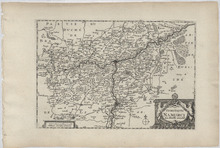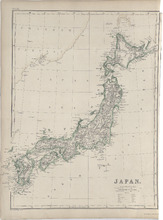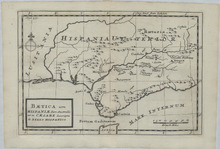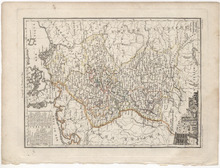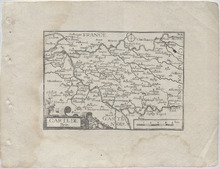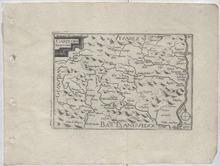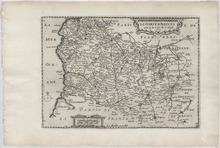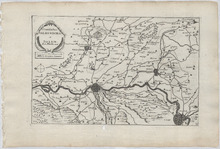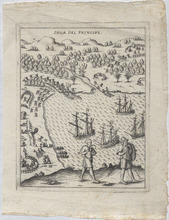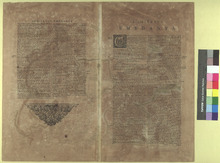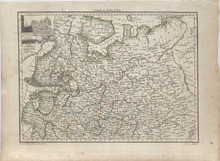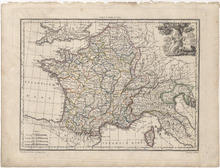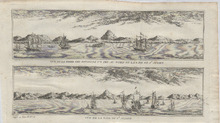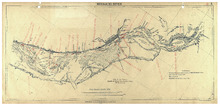Comitatus Namurci (1702)
This is a highly detailed copper engraved map of the area around Namur, Belgium. There is a mileage cartouche and a title cartouche. This is from the publication, Atlas portatif, ou, le nouveau theatre de la guerre en Europe: contenant les cartes geographiques, avec les plans des villas & fortresses les plus exposees aux revolutions presented: accompagne d'une nouvelle methode pour apprendre facilement la geographie & la chronologie des potentats. A Amsterdam Chez Daniel de la Feuille 1702, which roughly translates in English to, Portable Atlas, or, The New Theatre of War in Europe Containing Geographical Maps, with City Plans and Fortress Plans which are most Exposed to the Revolution Presented: Accompanied by a New Method to Easily Learn Geography and Chronology. In Amsterdam by Chez Daniel de la Feuille in 1702. The title of the map is Comitatus Namurci La Feuille excudit which roughly translates to County Namur Printed by La Feuille. Daniel de La Feuille lived from 1640 until 1709. He was from Sedan in Northern France and was born to Huguenot parents. In 1683, he and his family fled religious persecution to Amsterdam and became an engraver and cartographer. Cities appearing in the map: Belgium: Liège: Eynges (Engis), Floen (Flône), Aymoin (?), Herion (?), Fisfontaine (Fize-Fontaine), Ouhe (?), Vignamot (?), Feumal (Fumal), Falays (Fallais), Coutuin (?), Hosdain (Hosdent?), Breft (?), Mox (Moxhe), Aum (?), Crehe (Crehen), Haesche (Hannêche), Acache, Emptines, Messle, Ambesmeau, Chiple, Mouha, Coutuin, Han, Mozey, Haesche (Hannêche), Acache (Acosse), Meffle (Meeffe), Ambesmeau (Ambrésinaux), Chiple (?), Mouha (Moha), Coutuin (?), Han (?), Mozey (?), Namur: Braehan (Branchon), Fraquees (Franquenée), Tauiers (Taviers), Hettemot (?), Asche en refail (Aische-en-Refail), Gemblours (Gembloux), Conroy (Corroy-le-Château), Aurenault, Sombreff (Sombreffe), Ligny, Boegne (Boignée), Bagny (?), Mons (?), Hauere (?), Boety (Bothey), Tongre (Tongrinne), S. Martin (Saint-Martin), Masy (Mazy), Visne, Argenti (?), Meux, Fero (Ferooz), Tillon (?), Du (Dhuy), Liernu, Osltn (?), Mehaigne (Mehaigne/Noville-sur-Mehaigne), S. Denis (Saint-Denis-Bovesse), Esmynes (Émines), Chemen (?), Rime (?), Haule (?), Name (Namur), Le Faliec (?), Bernacome (?), Ponthy (?), Frize (?), Leuze, Dassoulx (?), Ypigney (Upigny), Franeqwarat (Franc-Waret), Fernemons (Fernelmont), Haure (?), Froncou (?), Nouille sur Mehaig (Noville-sur-Mehaigne), Boneff ab. (Boneffe/Boneffe Abbey), Recourt (?), Hambruie (Hambraine), Vodon (Cortil-Wodon), Emptines (Hemptinne), Forte Iles (?), Arz (?), Selles (Seilles), Malroy (?), Hingeon, Sosoy (?), Som (?), Naesche (Namêche), Ielhusee (?), Bonen (Boninne), Marche (Marche-les-Dames), Bez (Beez), Yanau (?), Florisont (Floreffe/Floriffoux), Iodion (Jodion), Templo (Temploux), Ymedame (?), Monslier (Moustier-sur-Sambre), Spy, Omme (?), Faume (?), Iemepye (Jemeppe-sur-Sambre), Tarsen (Tarcienne), Hansen (Hanzinne), Bersee (Berzée), Leneff (Laneffe), Thille Chast. (Thy-le-Château), Puy (?), Iardinet Abb. (?) Castre (Chastrès), Walcourt, Vogne (Vogenée), Yue (Yves-Gomezée), S. Aubain (Saint-Aubin), Dacheu (?), Iamuelle (Jamiolle), Viller Y Eglise (?), Philippeville, S. Zelle (?), Sauton (Sautour), Iamaigne (Jamagne), Waudesy (Vodecée), Franhimont (Franchimont), Louten (Lautenne), Hastiers (Hastière/Hastière-Lavaux/Hastière-par-delà), Wassers abb. (?), Poren (?), Minaoye (Miavoye), Maure (Maurenne), Frayers (Castle of Freÿr), Ierenne (?), Ante (Anthée), Moruille (Morville), Rosoy (Rosée), Florennes, Corenne, Forge (?), Walloon Brabant: Perwez, Threbaex (?), Gonensau (?), Pandese (?), Courtil (Cortil-Noirmont), Gemlines (Gentinnes), Viller (Villers-la-Ville), Houtham (?), Nivelle (Nivelles), Marbais, Hainaut: Petit Reulx (Petit-Rœulx-lez-Braine), Selle (Pont-à-Celles), Busee (Buzet), Renez (Rèves), Frane (Frasnes-lez-Gosselies), Liberche (Liberchies), Lut (Luttre), Brunehault (There is a street Chaussee Brunehault), Ville Paroy (?), Melle (Mellet), S. Amand (Saint-Amand), S. Bris (Brye), Wagny (Wangenies), Wauferche (Wanfercée-Baulet), Banley (?), Farse (Farciennes), Flerso (Fleurus), Telon (?), Chastelniau (Châtelineau), Charleroy (Charleroi), Gilly, Soreamol (Soleilmont), Heppenyes (Heppignies), Wagnelle (Wagnelée), Hegne (?), Gosseliers (Gosselies), Vinille (?), Plouy (?), Sartles moisni (Sartis), le Ron (?), Fonteineleuesque (Fontaine-l'Évêque), Marchien au pont (?), Gamigno (?), Court (?), Chastillan (Castillon), Cense (?), Bossu (?), Forge (?), Senlry (?), Conille (?), Acos (Acoz), Marcinelle (?), S. Nicolas (Sart Saint-Nicolas), Nalen (?), Gerpines (Gerpinnes), France: Alsace-Champagne-Ardenne-Lorraine: Ardennes: Charlemont (Charlemont fortress in Givet)
Member of
